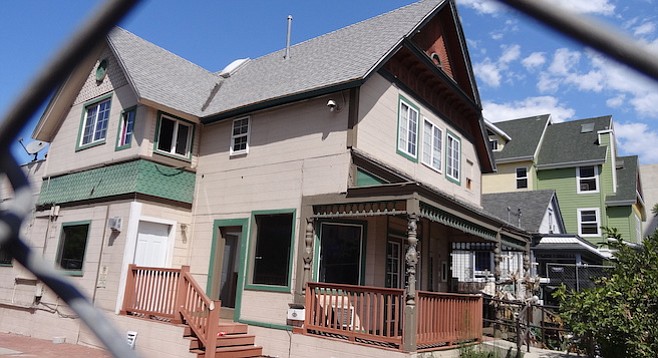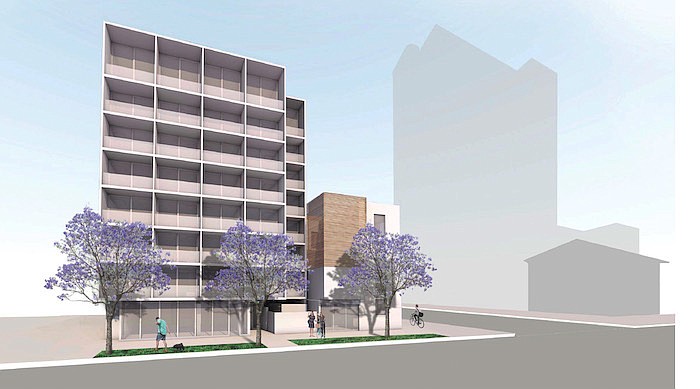 Facebook
Facebook
 X
X
 Instagram
Instagram
 TikTok
TikTok
 Youtube
Youtube

Architect/developer Jonathan Segal has applied to Civic San Diego to construct a 36-unit, 87-foot-tall, eight-story, all-studio apartment complex at a presumed historic site, at 320 W. Cedar Street in Little Italy. It would also include an attached four-story, single-family home. If approved, construction would begin approximately in February 2017, with completion in a year.

The development requires a site development permit because the builder proposes to demolish a historic structure on the property. This is the Oscar M. Hillard, Queen Anne architectural style house, registered as number 282 in 1990 with the city’s Historic Review Board.
Save Our Heritage Organisation executive director Bruce Coons did not mention any planned protests but said the project “is in the most intact block of Victorian houses left in downtown.”
The rundown house has dual entrances, with another front door at 1610 Union Street. A nail salon vacated the property recently; it sold in June for $1,850,000 and is now surrounded by a privacy fence.
The developer is requesting an exemption because there won’t be any parking (though the four-story structure would have two parking spaces). To avoid the usual required parking at apartment buildings, the developer asked for an incentive via the city’s affordable-housing density bonus program.
Under that requested variance, two of the 400-square-foot studio units would be rented to tenants with very-low income. According to Brad Richter, CivicSD’s assistant VP for planning, the parking for apartments is “typically 0.5 spaces/unit required for a small lot like this one.”
Gary Smith, president of the San Diego Downtown Residents Group, sees it differently. His August 31 response was: “Yes, sigh; anything ‘affordable’ you can waive almost anything.”
The architectural firm’s Matthew Segal told the Reader: “The project would not be feasible with parking. The entire project would have to change. It is promoting walking, and alternative transportation means and methods, instead of providing parking.”
While LEED (Leadership in Energy and Environmental Design) buildings are in vogue, this structure won’t meet the criteria but will have roof solar panels. “We do not believe in LEED or its process,” Segal said. “The process itself essentially taxes the building and designer, in order to jump through hoops and loopholes to accumulate points.”
A public meeting of the Downtown Community Planning Council's pre-design subcommittee takes place September 13 at CivicSD offices. A CivicSD design review committee meeting is September 14, same location.
Subsequent design review meetings follow with Civic San Diego and the Downtown Community Planning Council; the Civic San Diego board and the city planning commission will make the final decision.
A recently completed Jonathan Segal project was the Mr. Robinson mixed-use residential building. Another project, with parking, is under construction at 4075 Park Boulevard in Hillcrest.


Architect/developer Jonathan Segal has applied to Civic San Diego to construct a 36-unit, 87-foot-tall, eight-story, all-studio apartment complex at a presumed historic site, at 320 W. Cedar Street in Little Italy. It would also include an attached four-story, single-family home. If approved, construction would begin approximately in February 2017, with completion in a year.

The development requires a site development permit because the builder proposes to demolish a historic structure on the property. This is the Oscar M. Hillard, Queen Anne architectural style house, registered as number 282 in 1990 with the city’s Historic Review Board.
Save Our Heritage Organisation executive director Bruce Coons did not mention any planned protests but said the project “is in the most intact block of Victorian houses left in downtown.”
The rundown house has dual entrances, with another front door at 1610 Union Street. A nail salon vacated the property recently; it sold in June for $1,850,000 and is now surrounded by a privacy fence.
The developer is requesting an exemption because there won’t be any parking (though the four-story structure would have two parking spaces). To avoid the usual required parking at apartment buildings, the developer asked for an incentive via the city’s affordable-housing density bonus program.
Under that requested variance, two of the 400-square-foot studio units would be rented to tenants with very-low income. According to Brad Richter, CivicSD’s assistant VP for planning, the parking for apartments is “typically 0.5 spaces/unit required for a small lot like this one.”
Gary Smith, president of the San Diego Downtown Residents Group, sees it differently. His August 31 response was: “Yes, sigh; anything ‘affordable’ you can waive almost anything.”
The architectural firm’s Matthew Segal told the Reader: “The project would not be feasible with parking. The entire project would have to change. It is promoting walking, and alternative transportation means and methods, instead of providing parking.”
While LEED (Leadership in Energy and Environmental Design) buildings are in vogue, this structure won’t meet the criteria but will have roof solar panels. “We do not believe in LEED or its process,” Segal said. “The process itself essentially taxes the building and designer, in order to jump through hoops and loopholes to accumulate points.”
A public meeting of the Downtown Community Planning Council's pre-design subcommittee takes place September 13 at CivicSD offices. A CivicSD design review committee meeting is September 14, same location.
Subsequent design review meetings follow with Civic San Diego and the Downtown Community Planning Council; the Civic San Diego board and the city planning commission will make the final decision.
A recently completed Jonathan Segal project was the Mr. Robinson mixed-use residential building. Another project, with parking, is under construction at 4075 Park Boulevard in Hillcrest.
Comments